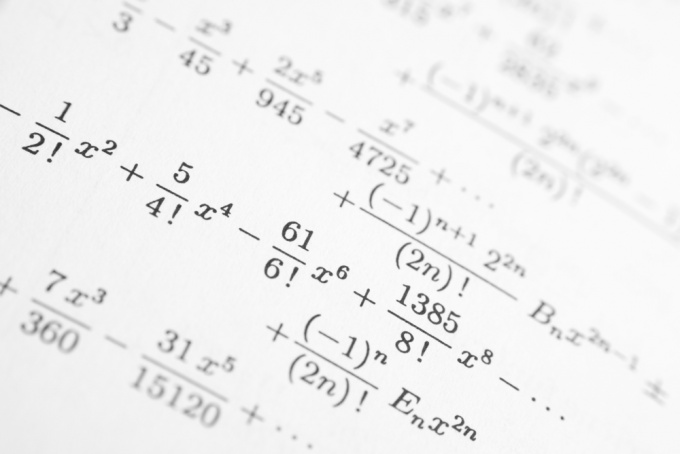Instruction
1
When dividing fractions, multiply the first fraction (numerator) by the inverted second fraction (the divisor). Such a fractionwhere the numerator and denominator are reversed is called reverse (to source).
When dividing fractions it is necessary to check that the second fraction and the denominators of both fractions are not equal to zero (or did not take zero values at certain values of parameters/variables/unknown). Sometimes, due to cumbersome fractions, it is very obvious. All values of variables (parameters), converting to zero the divisor (the second fraction) or denominators of fractions must be specified in the response.
Example 1: to divide 1/2 by 2/3
1/2 : 2/3 = 1/2 * 3/2 = (1 * 3) / (2 * 2) = 3/4, or
Example 2: split a/C to x/s
a/s : x/s = and/s * /x = (a*C)/(C*x) = a/x, where ? 0, x ? 0.
When dividing fractions it is necessary to check that the second fraction and the denominators of both fractions are not equal to zero (or did not take zero values at certain values of parameters/variables/unknown). Sometimes, due to cumbersome fractions, it is very obvious. All values of variables (parameters), converting to zero the divisor (the second fraction) or denominators of fractions must be specified in the response.
Example 1: to divide 1/2 by 2/3
1/2 : 2/3 = 1/2 * 3/2 = (1 * 3) / (2 * 2) = 3/4, or
Example 2: split a/C to x/s
a/s : x/s = and/s * /x = (a*C)/(C*x) = a/x, where ? 0, x ? 0.
2
To divide mixed fractions, you need to bring them to the ordinary mind. Next, act as in claim 1.
To convert a mixed fraction to an ordinary mind it is necessary the whole part times the denominator and then add this product to the numerator.
Example 3: convert the mixed fraction 2 2/3 in common:
2 2/3=(2 + 2*3)/3=8/3
Example 4: to divide fraction 3 4/5 to 3/10:
3 4/5 : 3/10 = (3*5+4)/5 :3/10 = 19/5 : 3/10 = 19/5 * 10/3 = (19*10)/(5*3)=38/3=12 2/3
To convert a mixed fraction to an ordinary mind it is necessary the whole part times the denominator and then add this product to the numerator.
Example 3: convert the mixed fraction 2 2/3 in common:
2 2/3=(2 + 2*3)/3=8/3
Example 4: to divide fraction 3 4/5 to 3/10:
3 4/5 : 3/10 = (3*5+4)/5 :3/10 = 19/5 : 3/10 = 19/5 * 10/3 = (19*10)/(5*3)=38/3=12 2/3
3
When dividing fractions, different types (mixed, decimal, common), all the fractions previously given to the ordinary mind. Further, according to claim 1. A decimal fraction is translated into common is very simple: the numerator is written decimal fraction without the decimal, and the denominator order fractions (tenths to ten, a hundred for hundredths, etc.).
Example 5: allow the decimal fraction 3,457 ordinary mind:
since fractions are "mils" (thousandths 457), and the denominator will be equal to 1000:
3,457=3457/1000
Example 6: divide a decimal fraction to a mixed 1,5 1 1/2:
1,5 : 1 1/2 = 15/10 : 3/2 = 15/10 * 2/3 = (15*2)/(10*3) = 30/30 = 1.
Example 5: allow the decimal fraction 3,457 ordinary mind:
since fractions are "mils" (thousandths 457), and the denominator will be equal to 1000:
3,457=3457/1000
Example 6: divide a decimal fraction to a mixed 1,5 1 1/2:
1,5 : 1 1/2 = 15/10 : 3/2 = 15/10 * 2/3 = (15*2)/(10*3) = 30/30 = 1.
4
When dividing two decimal fractions, both pre-multiplied by 10 to the extent that the divisor was a whole number. After dividing decimals "completely".
Example 7: 2,48/12,4=24,8/124=0,2.
If necessary (based on the conditions of the problem), you can find a multiplier value, to become whole as the divisor and the dividend. Then the task of dividing decimals is reduced to the division of integers.
Example 8: 2,48/12,4=248/1240=0,2
Example 7: 2,48/12,4=24,8/124=0,2.
If necessary (based on the conditions of the problem), you can find a multiplier value, to become whole as the divisor and the dividend. Then the task of dividing decimals is reduced to the division of integers.
Example 8: 2,48/12,4=248/1240=0,2
